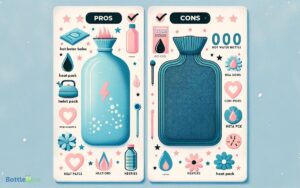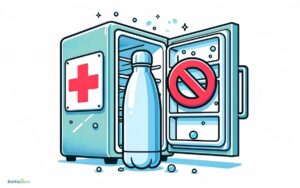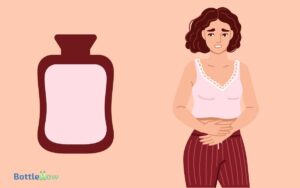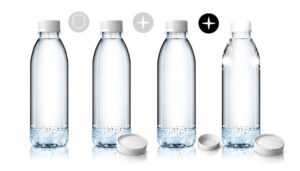Does a Hot Water Bottle Help Gastritis? Yes!
Yes, using a hot water bottle can help relieve gastritis symptoms. Heat therapy works by relaxing stomach muscles, reducing muscle tension, and increasing blood circulation.
Scientific evidence supports its use as a thorough treatment for managing gastritis discomfort, such as abdominal pain and bloating.
To use it effectively, fill a hot water bottle with warm water (around 104°F), wrap it in a cloth, and place it on your abdomen for 15-20 minutes.
Be cautious to avoid burns and monitor for skin redness. For those interested in exploring further, more detailed insights await.
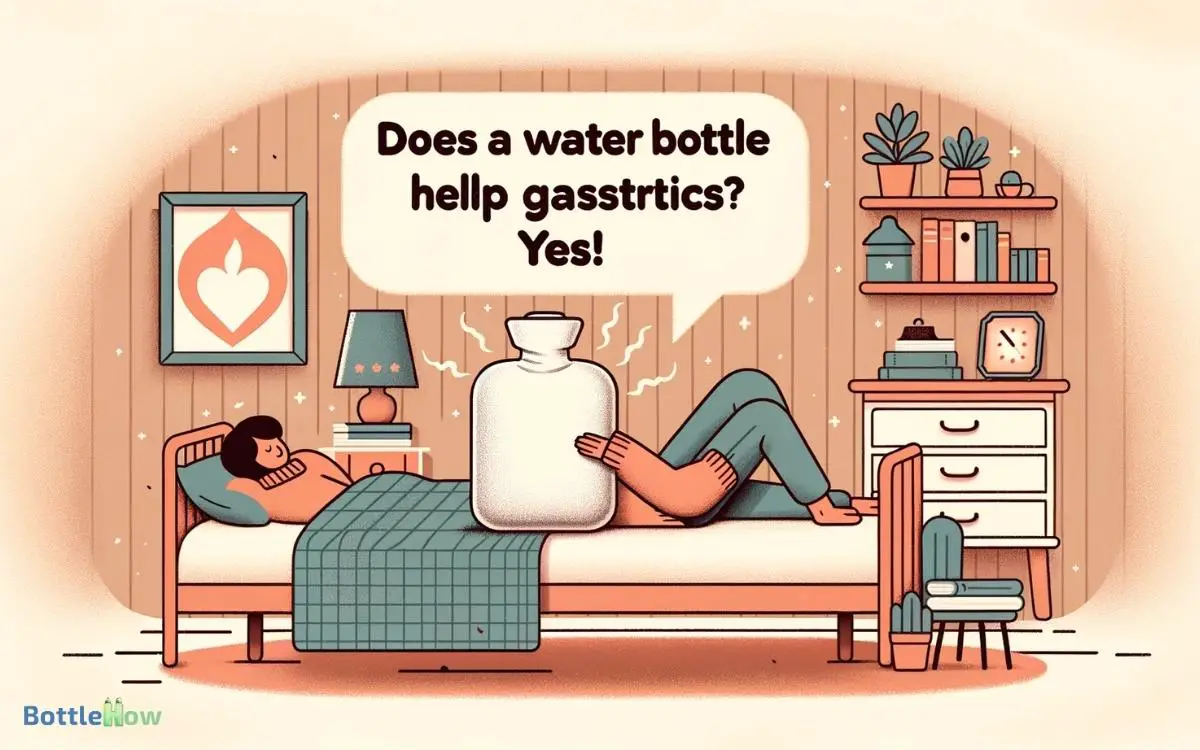
Key Takeaways
Understanding Gastritis
Gastritis is an inflammation of the stomach lining caused by various factors, including infections, prolonged use of NSAIDs, and excessive alcohol consumption.
When you have gastritis, the protective mucous layer of your stomach becomes weakened or damaged. This allows stomach acid to irritate the lining, leading to inflammation.
Helicobacter pylori infection is a common culprit, affecting a significant number of individuals globally.
Nonsteroidal anti-inflammatory drugs (NSAIDs) like ibuprofen can also disrupt the stomach’s mucosal barrier.
Additionally, chronic alcohol consumption can erode the mucous lining, making it susceptible to acid damage.
Understanding these causative factors helps in diagnosing and managing gastritis more effectively.
By pinpointing the underlying cause, you can better tailor treatment strategies to alleviate the condition.
Common Symptoms
Patients often experience a range of symptoms, including abdominal pain, nausea, and bloating, which can vary in severity and duration. These symptoms occur due to inflammation of the stomach lining, known as gastritis.
You might also notice a burning sensation in your upper abdomen, particularly between meals or at night.
Some patients report feeling full quickly during meals, which can contribute to a reduced appetite and subsequent weight loss. Additionally, vomiting or a sensation of indigestion can be common.
It’s essential to recognize these symptoms early, as chronic gastritis can lead to complications like ulcers or even stomach bleeding.
Monitoring symptom patterns can help in determining the underlying cause and guiding appropriate treatment strategies.
Traditional Treatments
Often, traditional treatments for gastritis involve dietary modifications, medications to reduce stomach acid, and lifestyle changes to alleviate symptoms.
You should avoid spicy foods, caffeine, and alcohol, as these can exacerbate inflammation. Proton pump inhibitors (PPIs) and H2 blockers are effective in lowering stomach acid production, providing relief from pain and discomfort. Additionally, antacids can neutralize existing stomach acid, offering quick symptom relief.
You should also consider lifestyle adjustments such as quitting smoking, reducing stress, and maintaining a healthy weight.
Eating smaller, more frequent meals can prevent the stomach from becoming overly full, which might help reduce symptoms.
Role of Heat Therapy
You’ll find that heat therapy can greatly alleviate abdominal pain associated with gastritis by relaxing the stomach muscles.
Applying a hot water bottle also helps reduce muscle tension and enhances blood circulation to the affected area, promoting healing.
Scientific evidence supports these benefits, making heat therapy a viable complementary treatment for gastritis symptoms.
Alleviating Abdominal Pain
Applying a hot water bottle to the abdomen can greatly alleviate pain associated with gastritis by increasing blood flow and relaxing muscle tension.
This method works by dilating blood vessels, which enhances nutrient delivery and waste removal in affected tissues. The localized heat application can also interrupt pain signals, providing a soothing effect.
Here’s how heat therapy helps:
| Benefit | Mechanism | Result |
|---|---|---|
| Increased blood flow | Vasodilation | Enhanced nutrient delivery |
| Pain signal blocking | Nerve desensitization | Reduced pain perception |
| Muscle relaxation | Heat-induced relaxation | Immediate comfort |
| Inflammation reduction | Improved blood circulation | Decreased swelling |
Reducing Muscle Tension
Heat therapy effectively reduces muscle tension by promoting muscle relaxation and increasing tissue pliability.
When you apply a hot water bottle to your abdomen, the heat penetrates deep into the muscle layers. This process enhances the elasticity of muscle fibers and decreases stiffness.
Studies have shown that heat therapy can reduce the sensation of pain by altering the neural transmission of pain signals, making you more comfortable.
Moreover, the warmth can help in reducing the accumulation of lactic acid in muscles, which often contributes to cramping and discomfort.
Enhancing Blood Circulation
In addition to reducing muscle tension, heat therapy greatly enhances blood circulation by causing the blood vessels to dilate, which increases blood flow to the affected area.
This improved circulation can aid in the healing process and alleviate discomfort associated with gastritis.
Here are four key benefits:
- Nutrient Delivery: Enhanced blood flow delivers essential nutrients and oxygen to damaged tissues, promoting faster repair.
- Waste Removal: Increased circulation helps remove metabolic waste products from the affected area more efficiently.
- Inflammation Reduction: The improved blood flow can help reduce inflammation, easing gastritis symptoms.
- Pain Relief: Better circulation can lead to decreased pain levels by reducing muscle spasms and improving tissue health.
How Heat Affects Pain
Research shows that heat therapy can significantly alleviate pain by increasing blood flow and relaxing muscle tension.
When you apply heat, it dilates blood vessels, enhancing circulation and delivering more oxygen and nutrients to the affected area.
This process helps reduce pain and accelerates tissue healing. Heat also decreases muscle spasms, which can be a common source of discomfort.
| Mechanism | Effect |
|---|---|
| Increased blood flow | Enhanced oxygen delivery |
| Muscle relaxation | Reduced tension and spasms |
| Vessel dilation | Improved nutrient supply |
Using a hot water bottle can be an effective, non-invasive way to manage pain. However, you should always make sure the temperature is safe to avoid burns.
Understanding these mechanisms helps you make informed choices about your pain management strategies.
Scientific Evidence
Numerous clinical studies support the efficacy of heat therapy, particularly through the use of hot water bottles, in alleviating symptoms associated with gastritis.
Research indicates that applying heat can:
- Reduce Pain: Heat increases blood flow, which can alleviate stomach pain by relaxing muscles and easing tension.
- Enhance Healing: Improved circulation aids in delivering nutrients and oxygen to the affected area, promoting faster healing.
- Diminish Inflammation: Heat can reduce inflammation by dilating blood vessels, which helps to flush out inflammatory substances.
- Improve Comfort: The soothing effect of warmth can provide immediate comfort, reducing the patient’s stress and anxiety.
These findings underscore the therapeutic potential of hot water bottles in managing gastritis symptoms, making them a valuable adjunct to traditional medical treatments.
Using a Hot Water Bottle
When using a hot water bottle for gastritis, you should understand its pain relief mechanism. This involves applying heat to your abdominal area to relax muscles and improve blood flow.
Place the hot water bottle over your stomach while lying down, ensuring it’s not too hot to avoid burns.
Limit each session to 20 minutes to maximize benefits without causing skin irritation.
Pain Relief Mechanism
Applying a hot water bottle to the abdomen can alleviate gastritis pain by increasing blood flow and relaxing stomach muscles.
The warmth from the hot water bottle helps dilate blood vessels, promoting improved circulation. This process can facilitate the delivery of oxygen and nutrients to the affected area, aiding in the healing process. Additionally, the heat can help relax the muscles in the affected region, reducing tension and discomfort. Using a hot water bottle for hemorrhoids may also soothe irritation and provide temporary relief from pain and itching. Regular application can contribute to overall comfort and assist in the healing process.
Additionally, the heat relaxes the smooth muscle of the stomach, reducing cramping and discomfort.
- Increased Blood Flow: Enhanced circulation brings more oxygen to inflamed tissues.
- Muscle Relaxation: Heat reduces muscle tension, alleviating pain.
- Nerve Signal Modulation: Warmth can interfere with pain signals sent to the brain.
- Stress Reduction: Comforting heat can reduce overall stress, impacting pain perception.
Understanding these mechanisms can help you effectively manage gastritis symptoms.
How to Apply
To effectively use a hot water bottle for gastritis relief, follow these steps:
- Fill the bottle with hot (but not boiling) water and securely close the cap to prevent leaks.
- Confirm the water temperature is around 104°F to 113°F (40°C to 45°C), as this range is ideal for soothing pain without causing burns.
- Wrap the hot water bottle in a cloth or towel to avoid direct skin contact, which can lead to burns or irritation.
- Place the wrapped bottle on your abdomen, focusing on the area where you feel discomfort.
- Maintain a comfortable position, either sitting or lying down, to allow the heat to penetrate the abdominal muscles, promoting relaxation and reducing pain.
- Always monitor your skin’s reaction to prevent overheating.
Duration of Use
Limit the use of a hot water bottle to 15-20 minutes per session to prevent skin damage and guarantee therapeutic efficacy. Prolonged exposure can lead to burns, blisters, or even exacerbate symptoms.
To maximize benefits while minimizing risks, follow these guidelines:
- Monitor Temperature: Confirm the water temperature is comfortable and not scalding, ideally around 104°F (40°C).
- Use a Cover: Always utilize a cloth cover to buffer direct heat contact and reduce the risk of burns.
- Check Skin: Periodically inspect the skin for any signs of redness or irritation.
- Rest Periods: Allow at least 2 hours between sessions to let your skin recover and avoid overheating.
Safety Precautions
Ensuring safety while using a hot water bottle for gastritis involves understanding the risks of burns and the importance of proper temperature control.
Always use warm, not boiling, water—ideally around 104°F (40°C). Fill the bottle to two-thirds full to prevent leaks. Inspect the bottle for cracks or wear before each use, as damaged bottles can burst.
Use a cloth cover to avoid direct skin contact, which can cause burns even with moderate temperatures. Limit application time to 15-20 minutes and avoid falling asleep with the bottle in place.
If you experience discomfort or skin redness, discontinue use immediately. Following these precautions helps you safely benefit from the soothing effects of a hot water bottle on gastritis.
Conclusion
You’re probably wondering if a hot water bottle truly helps with gastritis. Imagine this: soothing heat easing your stomach pain.
While traditional treatments like antacids and dietary changes are essential, heat therapy offers an intriguing complementary option.
Scientific evidence suggests heat can alleviate pain by improving blood flow and relaxing muscles.
So, next time gastritis strikes, grab a hot water bottle. But remember, always consult your doctor first to make sure it’s the right choice for you.


